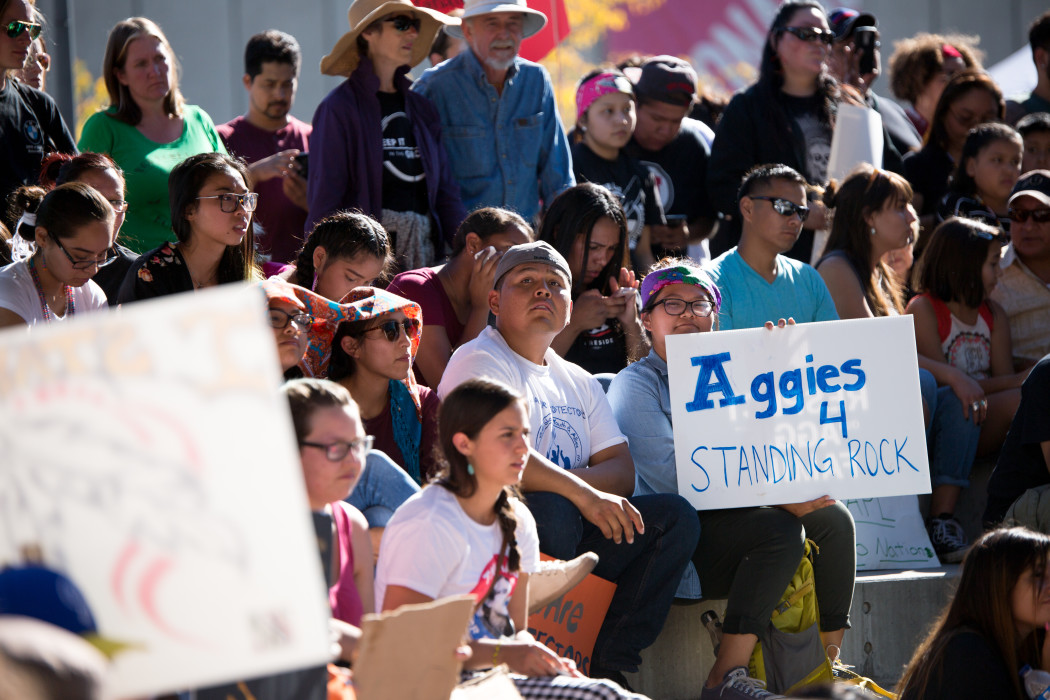Aggies stand for Standing Rock
Approximately 500 people stood in solidarity with those fighting against the Dakota Access Pipeline in Standing Rock, North Dakota at the Utah State Capitol in Salt Lake City on Saturday.
The protesters danced and offered prayers for those in Standing Rock who are fighting against the Dakota Access Pipeline from being built on Native American land. Those who oppose it are concerned about water access, water quality and losing sacred Sioux territory. Sioux is the Native American tribe that lives there.
Forty-three Aggies marched from the dry heat at the top of Utah’s Capitol Hill to the Salt Lake City Library. There, people gathered around the man-made waterfall and kids played in the fountain.
The march happened even after The Obama Administration ordered a voluntary construction halt on Sept. 9 for the DAPL. Angela Enno, founder of Aggies for Standing Rock, said the company didn’t honor that halt and is continuing construction regardless. However, the Statesman couldn’t find any information to back that claim.
“The fight isn’t won. What Obama did didn’t have any effect,” she said. “If anything, [protesting] has become more important. It’s important that we all stand up. We need our American citizens. We need our citizens of the world. Stand for our mother earth, and stand up for corruption.”
“I think everyone should be aware that media can censor knowledge, especially when it comes to not reporting on things like the DAPL,” said Tyra Hardin, a sophomore studying family and consumer human development who’s part of the Northwest Shoshone and Navajo tribes.
“Utah State University students don’t even know about it,” she said. “They’re not even aware.”
Hardin said the group is grateful to anyone who has contributed to the donations the NASC is collecting.
“If you want to help, donate to the people who will be there at Standing Rock until the winter,” she said.
Kason Hudman, who recently graduated from Utah State University with a degree in History, set up a donation bin nearly a week ago at St. John’s Episcopal Church in Logan. When he returned, there were two bins full of winter clothes and four bags of canned food.
“St. John’s Episcopal church really cleaned up,” he said.
Denisha Tsosie said she marched because she stands behind Standing Rock. Tsosie is Navajo and a senior studying business administration.
“I came here to stand as one nation, to support Standing Rock,” she said. “We all live on Mother Earth to keep it nice, clean, safe. We should support one another. No matter which tribe we represent, we should just support one another.”
This movement isn’t just important to me, but the tribes as a whole, Hardin said.
“Not only that, but the land that the pipeline is going into is sacred,” she said. “It’s important for us to protect it and protect mother earth.”
Julie Wardell is a part of the Pascua Yaqui Tribe and she’s a junior studying folklore. Wardell said when she sees reports of the violence that’s come out of the Standing Rock protests, she has conflicting feelings.
“When we’re standing all together, I feel like we are uniting as tribes,” she said. “That way it makes me feel hope. But on the other hand, it reminds me that America has a history of trying to oppress us.”
Frank Young, a sophomore studying environmental studies, said he showed up to the protest because the DAPL shouldn’t build a pipeline that inflicts problems on land that has spiritual significance.
“It’s a human rights issue, and human rights issues affect everyone,” he said. “Someday, you could be the one who will be oppressed. It’s important to share your support.”
Young believes the ideal solution would be to not build it at all, though he doesn’t think that’s a reality.
“We just need to try to get the best out of it that we can, even if that’s not the perfect deal,” he said.
— morgan.pratt.robinson@gmail.com

